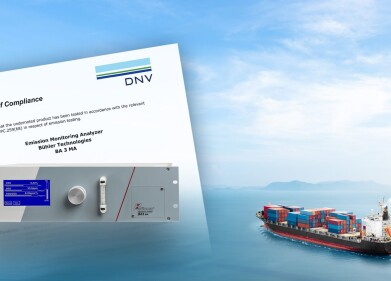Measurement and testing
Novel Thermowell and New Flameproof Temperature Sensors
Sep 27 2010
Okazaki Manufacturing Company (OMC) has developed a unique design of thermowell that is easily and safely installed in process pipelines if a standard thermowell has failed the ASME Performance Test Code (PTC 19.3, 2004).
ASME PTC 19.3 is not a design standard and should only be used by thermowell manufacturers to prove that their designs are suitable for the process conditions. Up to now, if a thermowell failed this performance test code, the manufacturer has been left with several options: either to shorten the thermowell immersion, or to increase the diameter of the thermowell, neither of which are practical or cost effective for the end user. The cost of manpower and replacing or refitting thousands of thermowells on a petrochemicals site in order to shorten the immersion is prohibitive. Similarly, the cost of increasing the diameter of the thermowell can also be considerable if the end user needs to purchase significant volumes.
The other option used by many thermowell suppliers is to incorporate a velocity collar on the thermowell in order to move the point of vibration or resonance. But adding a collar means that the thermowell and corresponding nozzle need to be manufactured to a high tolerance. This ensures a tight fit so that no resonance can occur. While this solution works, the extra costs incurred by the thermowell manufacturer are invariably passed on to the buyer.
However, following extensive R&D and independent evaluation, OMC’s VortexWell® thermowell incorporates an innovative helical strake design that eliminates the need for a velocity collar. This is cost effective in terms of purchasing, installation and maintenance costs (whole lifecycle costs).
By using the latest computational fluid dynamics software to visualise the flow behaviour, OMC was able to accurately compare a standard tapered thermowell with its new VortexWell®. While the standard tapered thermowell showed classic shedding behaviour as expected, the VortexWell® demonstrated no signs of regular flow behaviour. The helical strake design disturbed the flow sufficiently to interrupt the regular formation of vortices. Whilst a small vortex was observed in the wake of the VortexWell® this was a localised stagnation point and didn’t shed.
Another key observation was made with regard to the pressure fields. For the standard tapered well, an oscillating pressure field was observed around the structure. The VortexWell® displayed a constant and stable pressure field, presenting no dynamic variations. As this pressure is the source of vortex-induced vibrations, the VortexWell® experiences a significant improvement in practise compared to the standard thermowell design.
In further tests, this time using FEA software, OMC discovered that the ASME calculations (PTC 19.3, 2004) used by thermowell manufacturers could place significant limitations upon the safety of petrochemical applications. Using the ASME calculations gave the lowest natural frequency of vibration for the standard tapered thermowell to be 68.5Hz. However, OMC’s own FEA results showed a corresponding value of 90.3Hz, a 30% difference. This highlights that the ASME calculations design rules include assumptions that can lead to considerable inaccuracies when designing thermowells for petrochemical applications. The risk of a thermowell failing due to under-engineering, or the extra costs incurred by the end user because of an over-engineered unit, can both be avoided if the buyer works with OMC.
Digital Edition
PIN 26.1 Feb/Mar 2025
March 2025
Analytical Instrumentation - Elemental Analysis for Quality and Process Control at Refineries, for Lubricants and Wear Metals in Engine Oils - Synthetic Lubricants: New Developments - Scaling...
View all digital editions
Events
Apr 08 2025 Birmingham, UK
Apr 08 2025 Kielce, Poland
Apr 08 2025 Ravenna, Italy
Apr 08 2025 Southampton, UK
Apr 08 2025 London, UK



















